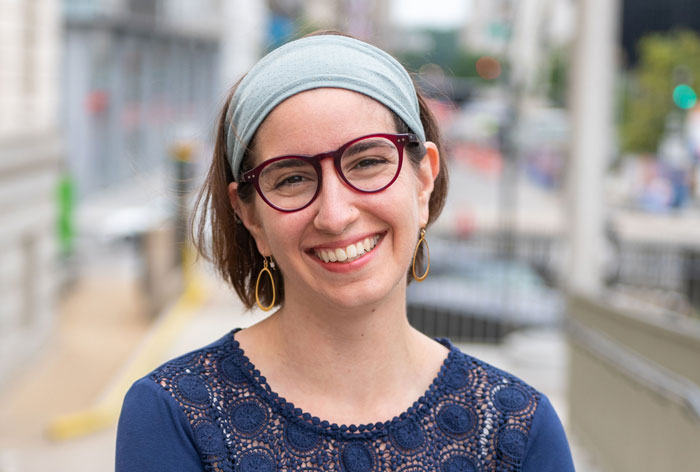This past year has been a reckoning with isolation. As a result of the pandemic, many of us have been cut off from friends and family and forced, at worst, to go it alone, and at best to band together with a small group of family and friends until we are able to re-emerge on the other side of this. We have had to celebrate joys, mourn sadness, and struggle with illness without the support of the communities upon which we hold dear. The hope for many of us, however, is that this period of isolation, however painful and strange and long it has been, is temporary, and that soon, we can return to each other.
For many, however, this feeling of isolation is not temporary. Some who struggle with illness, both physical and mental, are no strangers to isolation. The stigma associated with illness sometimes pushes people to turn inward out of fear or shame, at the moments in which they most need the support of a caring community. We see this pain of stigma and isolation at work in this week’s parsha, Tazria-Metzora, in which we learn about the leper’s forced separation from the community for the sake of protecting everyone else.
According to the Torah, when a person comes down with leprosy, the burden falls on the individual to alert the community and remove themselves from their midst. A newly-afflicted leper must take on the public markers of mourning like ripping one’s clothes to indicate to the community that they are ill. However, in the case of a leper, the alerting of the community doesn’t stop there. The leper must call out about themselves, “Tamei, tamei! Impure, impure!” so that everyone knows to stay far away. The Torah teaches that the leper must remove themselves from the community, dwelling alone outside the camp, as long as they are sick (Leviticus 13:45-46).
We see this firsthand in the story of Miriam. When Miriam is struck with tza’raat as a result of speaking up to Moshe, she is forced out of the camp at God’s order. Painfully, harshly, God instructs, “If her father spat in her face, would she not be disgraced for seven days?”(Numbers 12:14). On God’s word, Miriam, at a moment in which she is no doubt afraid and ashamed, is shut out of community.
Tamar Biala, author of many modern midrashim and co-editor of the collection of modern feminist midrashim “Dirshuni,” offers a powerful imagination of Miriam’s re-entrance back into the community. In her midrash “Miriam’s Passing,” she writes, “From the day that Miriam returned to the encampment, God’s statement about her ‘would she not be disgraced?’ (Numbers 12:14) was fulfilled and she hid in the tent and no longer revealed herself to the Children of Israel.” God instructed that Miriam should bear her shame for the seven days in which she was in isolation from the community. However, according to Biala’s midrash, her disgrace does not end with her reintegration back into the camp. Rather, even once she returns, her own fear and shame keeps her hidden away in her tent, unable to reunite with her community. Biala then imagines that in the same way that Miriam hides herself away, plagued by the fear that her disease will return, her community similarly hides from her, their own fear preventing them from embracing her and welcoming her back in. Miriam is left alone in her fear and her shame without anyone to see her, to love her, to support her.
Concerned for the well-being of the rest of society, the Torah may seem harsh in its treatment of the leper. In a moment of sickness, a moment when someone may most need support, they must publicly announce their contagious status and are cast out by their community. On first read, how cruel it may seem that the leper must call out about themselves, “Tamei, tamei!” They are forced to make public their private sickness in a manner in which I can only imagine would generate feelings of shame and guilt.
In the Talmud, our sages offer us another way of understanding the Torah’s insistence that the leper declare himself tamei (impure). The sages teach that a person afflicted with leprosy is like a sick tree. In the same way that we mark diseased trees with a red “X” so that passersby know to pray for them, so too the leper must mark themselves with a metaphorical red “x.” They must call out, “Tamei, tamei,” in order that their community knows to pray for mercy on their behalf (Bavli Shabbat 67a). I am struck by this evocative image of standing in a forest full of trees, some of which are marked with red Xs. It is as if the trees are bleeding red and crying out for help; our role is to take notice and to pray for them.
According to this new interpretation, the leper must cry out “Tamei, tamei,” not to shame themselves and to warn the community to stay far away, but rather as a cry for help, to alert the community that they, like the mourner, need support. Rather than encourage the leper to slink off shamefully outside of the camp until the disease passes, the Torah pushes the afflicted person to share their illness with the community so that they may join with them and pray for their recovery. This is what Miriam wasn’t able to do. Rather than cry out for support, she turned inward toward her tent. Rather than her community reaching out to her, they turned away in fear.

Ultimately, contagion aside, whether a person chooses to share their emotional and physical struggles must be up to them. It is the right of the person to choose whether to make their illness public. But this text can teach us two things. First, it’s an invitation, when we feel safe, to invite people in and to call out for help when we need it. People can’t show up if we don’t let them know we need help. Second, it calls on us as a community to create an environment in which people feel safe to ask for help and it obligates us to show up for people when they do cry out. May this parsha teach us the importance of creating communities of comfort in which we destigmatize illness, listen for each other’s cries, and we feel safe enough to cry out ourselves when we are the ones in need of help.
Rabbi Avi Strausberg is director of national learning initiatives at Hadar in Washington, D.C. She is a 2015 graduate of the Rabbinical School of Hebrew College.
This post has been contributed by a third party. The opinions, facts and any media content are presented solely by the author, and JewishBoston assumes no responsibility for them. Want to add your voice to the conversation? Publish your own post here. MORE


